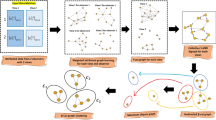Abstract
With the development of media technology, data types that cluster analysis needs to face become more and more complicated. One of the more typical problems is the clustering of multi-view data sets. Existing clustering methods are difficult to handle such data well. To remedy this deficiency, a multi-view weighted kernel fuzzy clustering method with collaborative evident and concealed views (MV-Co-KFCM) is put forward. To begin with, the hidden shared information is extracted from several different views of the data set by means of non-negative matrix factorization, then applied to this iterative process of clustering. This not only takes advantage of the difference information in distinct views, but also utilizes the consistency knowledge in distinct views. This pre-processing algorithm of extracting hidden information from multiple views (EHI-MV) is obtained. Furthermore, in order to coordinate different views during the iteration, a weight is distributed. In addition, so as to regulate the weight adaptively, shannon entropy regularization term is also introduced. Entropy can be maximized as far as possible by minimizing the objective function, thus MV-Co-KFCM algorithm is proposed. Facing 5 multi-view databases and comparing with 6 current leading algorithms, it is found that the algorithm which we put forward is more excellent as for 5 clustering validity indexes.
Access this chapter
Tax calculation will be finalised at checkout
Purchases are for personal use only
Similar content being viewed by others
References
Rodriguez, A., Laio, A.: Clustering by fast search and find of density peaks. Science 344(6191), 1492–1496 (2014)
Tang, Y.M., Ren, F.J., Pedrycz, W.: Fuzzy c-means clustering through SSIM and patch for image segmentation. Appl. Soft Comput. 87(1), 1–16 (2020)
Krishnapuram, R., Keller, J.: A possibilistic approach to clustering. IEEE Trans. Fuzzy Syst. 1(2), 98–110 (1993)
Pal, N.R., Pal, K., Bezdek, J.C.: A possibilistic fuzzy c-means clustering algorithm. IEEE Trans. Fuzzy Syst. 13(4), 517–530 (2005)
Ding, Y., Fu, X.: Kernel-based fuzzy c-means clustering algorithm based on genetic algorithm. Neurocomputing 18(8), 233–238 (2016)
Zhou, J., Chen, L., Chen, C.L.P.: Fuzzy clustering with the entropy of attribute weights. Neurocomputing 19(8), 125–134 (2016)
Yang, M.S., Nataliani, Y.: A feature-reduction fuzzy clustering algorithm based on feature-weighted entropy. IEEE Trans. Fuzzy Syst. 26(2), 817–835 (2019)
Greene, D., Cunningham, P.: A matrix factorization approach for integrating multiple data views. In: Buntine, W., Grobelnik, M., Mladenić, D., Shawe-Taylor, J. (eds.) ECML PKDD 2009. LNCS (LNAI), vol. 5781, pp. 423–438. Springer, Heidelberg (2009). https://doi.org/10.1007/978-3-642-04180-8_45
Lee, D.D., Seung, H.S.: Algorithms for nonnegative matrix factorization. Adv. Neural Inf. Process. Syst. 13(6), 556–562 (2001)
Lee, D.D., Seung, H.S.: Learning the parts of objects by non-negative matrix factorization. Nature 401(6755), 788–791 (1999)
Jiang, Y., Liu, J., Li, Z., Li, P., Lu, H.: Co-regularized PLSA for multi-view clustering. In: Lee, KM., Matsushita, Y., Rehg, J.M., Hu, Z. (eds.) ACCV 2012. LNCS, vol. 7725, pp. 202–213. Springer, Heidelberg (2013). https://doi.org/10.1007/978-3-642-37444-9_16
Tang, Y.M., Hu, X.H., Pedrycz, W., Song, X.C.: Possibilistic fuzzy clustering with high-density viewpoint. Neurocomputing 329(15), 407–423 (2019)
Acknowledgement
This research was supported by the National Natural Science Foundation of China (Nos. 61673156, 61877016, 61672202, U1613217, 61976078).
Author information
Authors and Affiliations
Editor information
Editors and Affiliations
Rights and permissions
Copyright information
© 2021 Springer Nature Singapore Pte Ltd.
About this paper
Cite this paper
Tang, Y., Xia, B., Ren, F., Song, X., Li, H., Wu, W. (2021). Multi-view Weighted Kernel Fuzzy Clustering Algorithm Based on the Collaboration of Visible and Hidden Views. In: Sun, Y., Liu, D., Liao, H., Fan, H., Gao, L. (eds) Computer Supported Cooperative Work and Social Computing. ChineseCSCW 2020. Communications in Computer and Information Science, vol 1330. Springer, Singapore. https://doi.org/10.1007/978-981-16-2540-4_9
Download citation
DOI: https://doi.org/10.1007/978-981-16-2540-4_9
Published:
Publisher Name: Springer, Singapore
Print ISBN: 978-981-16-2539-8
Online ISBN: 978-981-16-2540-4
eBook Packages: Computer ScienceComputer Science (R0)





